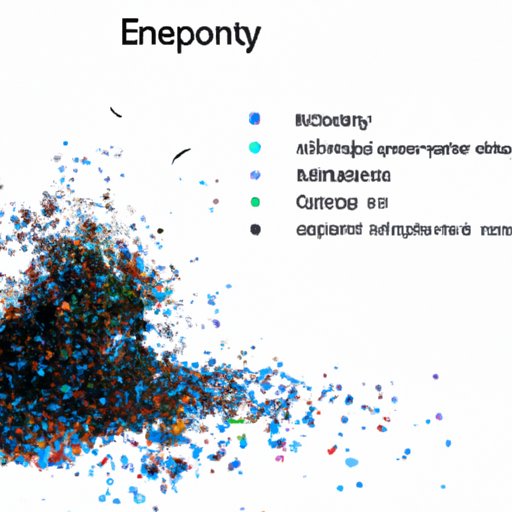Introduction
Entropy is an important concept in artificial intelligence (AI) that helps machines make decisions in uncertain situations. This article will explore the concept of entropy in AI and provide a beginner’s guide to understanding how it impacts decision-making in AI systems. We’ll also examine strategies for implementing entropy in AI applications and optimizing it for machine learning and neural networks.
Exploring the Concept of Entropy in Artificial Intelligence
Entropy is a measure of uncertainty or disorder in a system. In AI, entropy is used to represent the amount of uncertainty associated with a particular situation. It helps machines make decisions in uncertain environments by providing them with a way to quantify the level of disorder in a given situation.
What is Entropy?
Entropy, as defined by the Second Law of Thermodynamics, is “a measure of the amount of energy in a system that is not available to do work.” In other words, entropy measures the degree of disorder or randomness in a system. In AI, entropy is used to quantify the level of uncertainty associated with a particular situation. For example, a chess program may use entropy to measure the likelihood of winning or losing a particular game.
How is Entropy Calculated?
Entropy is typically calculated using the formula S = k log W, where S is the entropy, k is a constant, and W is the number of possible states in a system. In AI applications, entropy is calculated by looking at the probability distribution of the data points in a dataset and measuring the amount of information contained in each point. The more uncertainty there is in the data set, the higher the entropy.
Examples of Entropy in AI Systems
Entropy is used in many AI applications, including natural language processing (NLP), computer vision, and robotics. In NLP, entropy can be used to measure the uncertainty associated with a particular sentence or phrase. For example, if a sentence contains many words that have multiple meanings, it will have a higher entropy than a sentence with only one meaning. In computer vision, entropy can be used to measure the uncertainty associated with an image. If an image contains many objects with different shapes, sizes, and colors, it will have a higher entropy than an image with just one object. Finally, in robotics, entropy can be used to measure the uncertainty associated with a robot’s movements. If a robot is moving in an unpredictable manner, it will have a higher entropy than a robot that is moving in a predictable way.
A Beginner’s Guide to Understanding Entropy in AI
Entropy is an important concept in AI, but it can be difficult to understand. Here are some common terms and definitions that can help you better understand entropy and its role in AI decision making.
Common Terms and Definitions
In AI, entropy is a measure of uncertainty or disorder in a system. Entropy is measured using the formula S = k log W, where S is the entropy, k is a constant, and W is the number of possible states in a system. Entropy can be used to measure the amount of information contained in a dataset, the uncertainty associated with a sentence or phrase, or the unpredictability of a robot’s movements.
Different Types of Entropy
There are several different types of entropy that can be used in AI systems. These include Shannon entropy, which measures the amount of information contained in a dataset; Boltzmann entropy, which measures the uncertainty associated with a system; and Gibbs entropy, which measures the unpredictability of a system. Each type of entropy has its own unique characteristics and uses.
How to Measure Entropy
Entropy can be measured using the formula S = k log W, where S is the entropy, k is a constant, and W is the number of possible states in a system. For example, in a dataset with 10 data points, the entropy would be calculated by taking the logarithm of 10 (which is 1). Thus, the entropy of the dataset is 1.

An Overview of Entropy and its Role in AI Systems
Entropy plays an important role in AI decision making. It helps machines make decisions in uncertain environments by providing them with a way to quantify the level of disorder in a given situation. It also allows machines to make better predictions by helping them identify patterns and trends in large datasets.
The Role of Entropy in AI Algorithms
Entropy is used in many AI algorithms, including supervised and unsupervised learning algorithms. In supervised learning algorithms, entropy is used to identify patterns in labeled data. In unsupervised learning algorithms, entropy is used to measure the amount of disorder in a dataset. By measuring the amount of disorder in a dataset, machines can make better predictions about future events.
Benefits of Utilizing Entropy in AI Systems
The use of entropy in AI systems has many benefits. It allows machines to make better predictions by helping them identify patterns and trends in large datasets. It also helps machines make decisions in uncertain environments by providing them with a way to quantify the level of disorder in a given situation.
Challenges Involved in Leveraging Entropy
While entropy can be a powerful tool in AI decision making, there are also some challenges involved in leveraging it. For example, calculating the entropy of a dataset can be computationally intensive, and interpreting the results can be difficult. Additionally, entropy can be affected by external factors, such as noise or outliers, which can lead to inaccurate results.

Utilizing Entropy to Improve AI Performance
Entropy can be used to improve the performance of AI systems. Here are some strategies for implementing entropy in AI applications and optimizing it for machine learning and neural networks.
Strategies for Implementing Entropy in AI Applications
When implementing entropy in an AI application, it is important to consider the type of entropy being used and the specific task the AI system is trying to accomplish. For example, if the AI system is trying to identify patterns in a dataset, then Shannon entropy should be used. On the other hand, if the AI system is trying to measure the uncertainty associated with a sentence or phrase, then Boltzmann entropy should be used.
Optimizing Entropy for Machine Learning and Neural Networks
Entropy can also be optimized for machine learning and neural networks. This can be done by selecting the appropriate type of entropy for the task at hand and by ensuring that the entropy is calculated accurately. Additionally, it is important to ensure that the entropy is not overly affected by external factors, such as noise or outliers.
Examining the Relationship Between Entropy and AI Algorithms
It is also important to examine the relationship between entropy and AI algorithms. For example, some AI algorithms, such as reinforcement learning, rely heavily on entropy to make decisions. Other AI algorithms, such as supervised learning, do not rely on entropy as much and may even ignore it entirely. Knowing the role of entropy in different AI algorithms can help optimize the performance of AI systems.
Conclusion
Entropy is an important concept in AI that helps machines make decisions in uncertain situations. This article explored the concept of entropy in AI and provided a beginner’s guide to understanding how it impacts decision-making in AI systems. We also examined strategies for implementing entropy in AI applications and optimizing it for machine learning and neural networks.
Summary
In summary, entropy is a measure of uncertainty or disorder in a system. It is used in many AI applications, including natural language processing (NLP), computer vision, and robotics. Entropy is measured using the formula S = k log W, where S is the entropy, k is a constant, and W is the number of possible states in a system. Entropy can be used to measure the amount of information contained in a dataset, the uncertainty associated with a sentence or phrase, or the unpredictability of a robot’s movements. Entropy plays an important role in AI decision making, and it can be optimized for machine learning and neural networks by selecting the appropriate type of entropy and ensuring that the entropy is calculated accurately.
Final Thoughts on Entropy in AI
Entropy is an important concept in AI that helps machines make decisions in uncertain situations. It can be used to improve the performance of AI systems, but it is important to understand the challenges involved in leveraging entropy, such as computational intensity and external factors that can lead to inaccurate results. With a better understanding of entropy and its role in AI, developers can create more efficient and accurate AI systems.
(Note: Is this article not meeting your expectations? Do you have knowledge or insights to share? Unlock new opportunities and expand your reach by joining our authors team. Click Registration to join us and share your expertise with our readers.)
